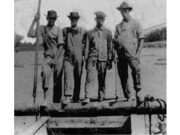Timber raftsmen played a major role in the economy of Georgia during the great building boom that followed the Civil War (1861-65). Their colorful story has eluded historians, but it survives in the folklore and oral traditions of south Georgia. Between 1870 and 1930 raftsmen supplied several timber mills in coastal Georgia with the raw material for ships, bridges, railroads, and buildings. In the 1880s huge schooners carried 100 million board feet of lumber from the port of Darien to destinations in America and Europe.
The earliest raftsmen were farmers of the river valleys of the Altamaha River and its tributaries, the Oconee, Ocmulgee, and Ohoopee. After harvesting field crops in the fall, they selected and felled their tallest longleaf pine trees. Several months later, the cured (dry) timbers were ready for “squaring up” with a broad ax. When the rivers rose in winter and spring, men gathered the timbers into rafts. Two sturdy logs formed a V at the front of the raft, allowing the craft to bounce off the many sharp turns of the serpentine river. Known as a “sharp chute,” the raft was a rectangular mass of floating logs that weighed about 360,000 pounds. The average raft was about the length of a basketball court, although somewhat narrower.
Oars or “sweeps” forty-five to fifty feet in length rested on “benches” at both ends of the raft. These served as both paddles and rudders, which rafthands pulled and pushed constantly with great effort. Their task was to keep the raft in the mainstream and away from snags and sandbars. The river’s current propelled the raft downstream. At minimum, three people worked on the raft: a pilot, an assistant pilot, and a roustabout, who also served as cook.
A raft that began its journey at Lumber City on the Ocmulgee River floated for twelve days before arriving in Darien. Along the way the pilot would “call the shots” for each turn. He barked instructions for oarsmen:”bow white” and “bow Injun,” meaning they must push or pull the raft to the north or south side of the river respectively. The terms originated in the early nineteenth century when Native Americans lived in the lands south of the Altamaha, having ceded the northern side to the state of Georgia.
The pilot knew how to direct the raft past potential disasters at places whose demonic names still survive on the Altamaha River: Devil’s Whirl, Devil’s Elbow, Hell’s Shoals, Little Hell, and Old Hell Bight. A mishap along the way meant the pilot and crew lost their wages, their timber, and occasionally their lives. Some place names refer specifically to the work of rafthands. At Point Pullaway, the crew would navigate the raft to the far side of the river. However, at Point-Pullaway-and-be-Damned, they struggled to avoid the far side. Among dozens of other dangerous places were Deadman’s Point and Kneebuckle Bend.
Most raftsmen knew well the story behind the place called Hannah’s Island, beside the swift-flowing waters of the Narrows southeast of Jesup. According to legend, in the 1800s some men stopped at the island and killed a woman named Hannah who lived there. Early in the twenty-first century, gruesome stories still circulate about men who met misfortune on the island at the hand of the vindictive ghost of Hannah, who appears when the moon is full.
Raftsmen developed traditions distinctive to their work. A ritual of initiation required each new rafthand to ensure good luck by tying an article of clothing to the willow tree at Rag Point. After selling the raft to timber merchants, raftsmen began the long walk home. Following custom, the pilot ordered the novice rafthand to carry a heavy wooden maul used in building the raft. On the third day, to the young man’s chagrin, the pilot instructed him to discard the cumbersome maul because he could easily make a new one. In six or seven days raftsmen arrived at their backwoods homes with treats for their families and themselves.
Immigrants from the British Isles settled much of southern Georgia and were among the earliest raftsmen. African Americans, however, also engaged in this work and contributed to rafting folklore; such work songs as “Pay Me My Money Down” are still popular in coastal Georgia. Folklore from the Altamaha River valley suggests that raftsmen of both races enjoyed both the responsibilities and the rewards of their rugged routine.




